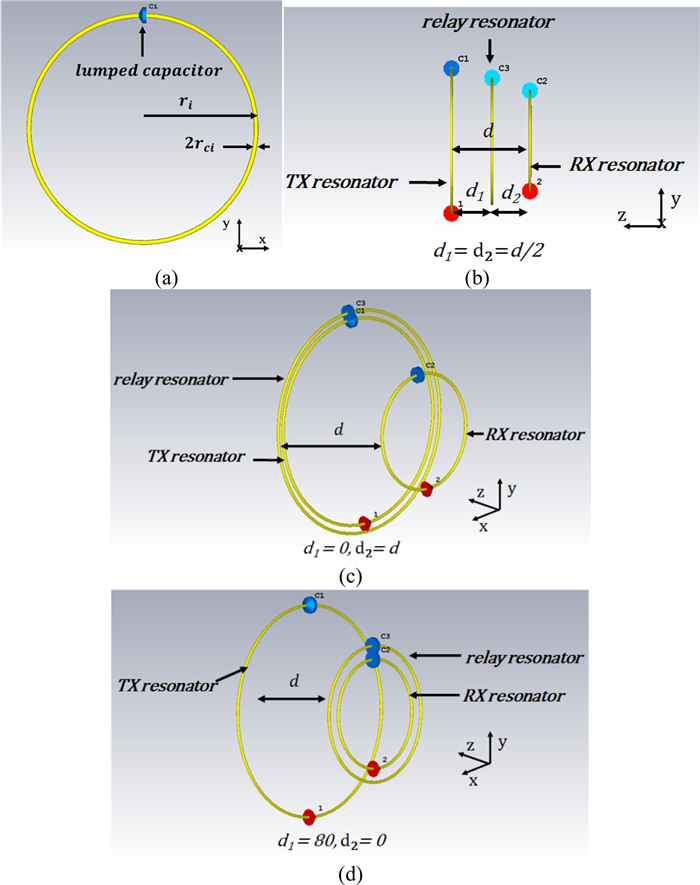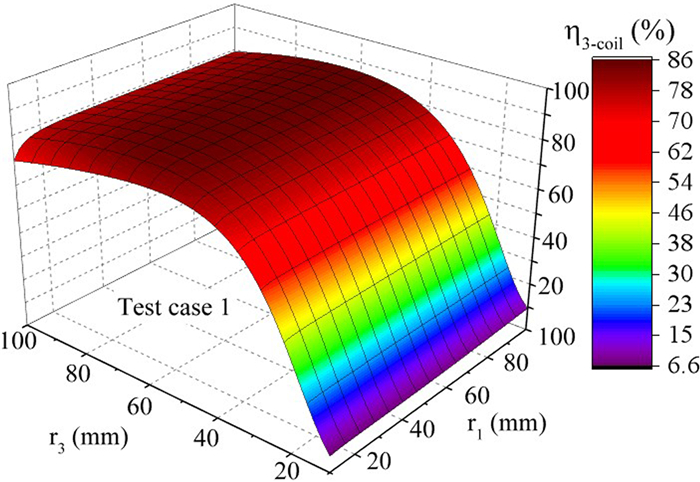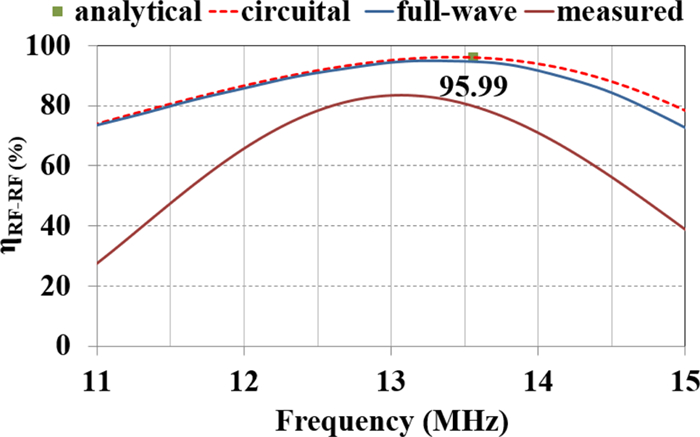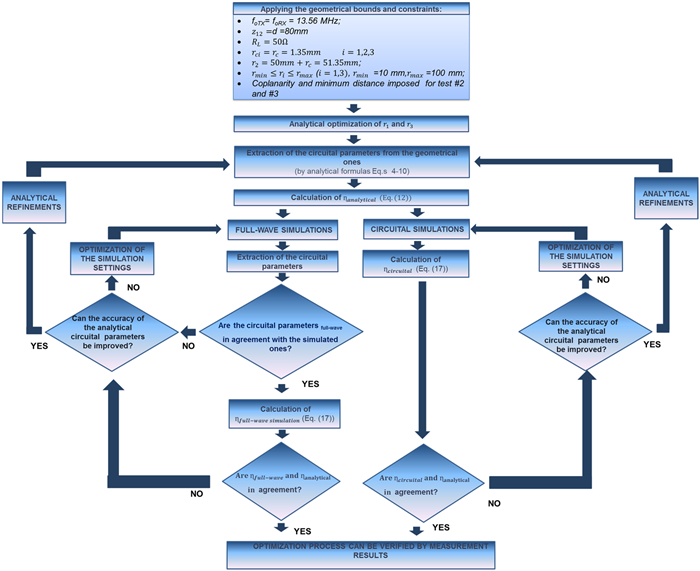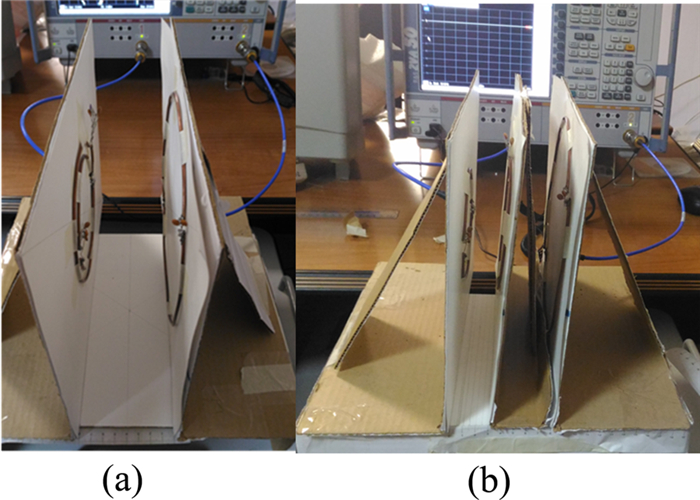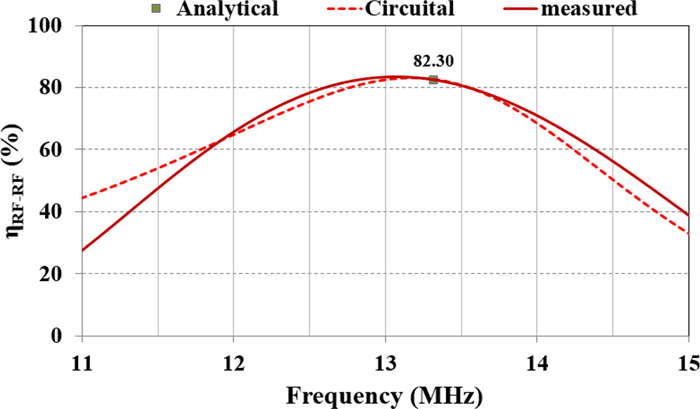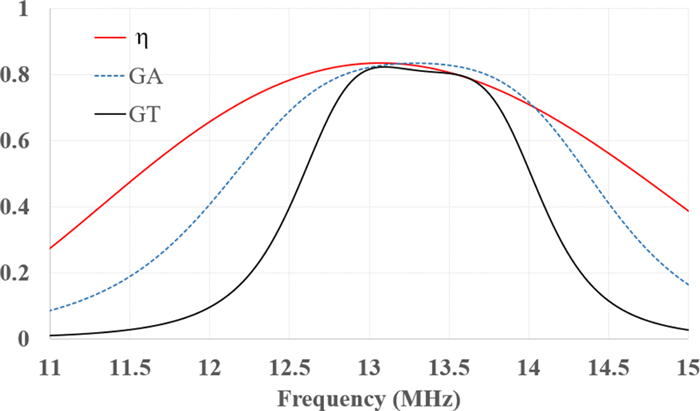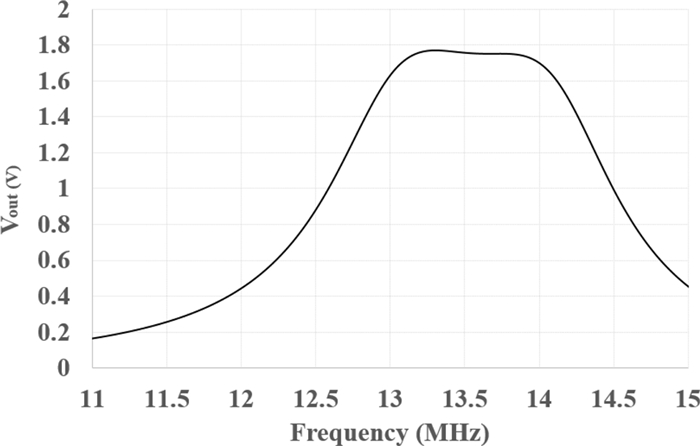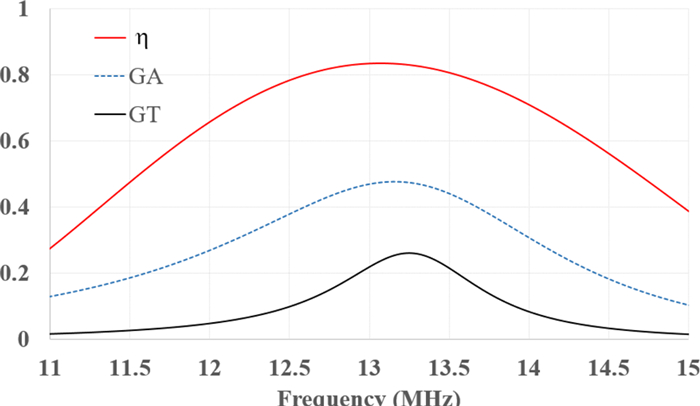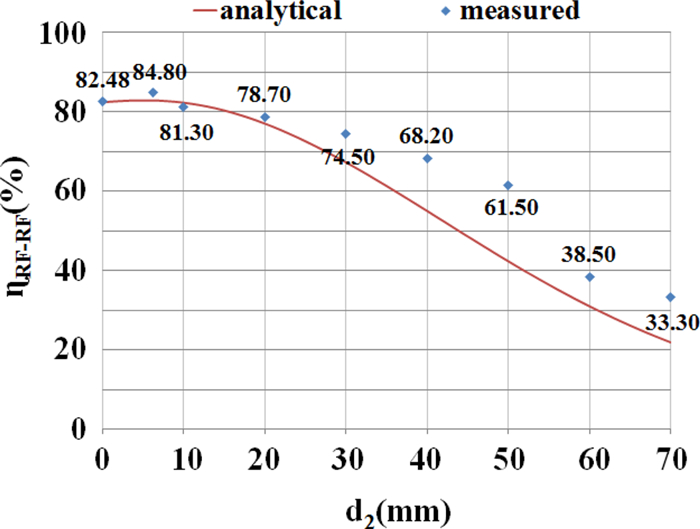Efficiency optimization of a three-coil resonant energy link
-
1.
Department of Innovation for Engineering, University of Salento, via per Monteroni snc, 73100, Lecce, Italy
-
2.
Heriot-Watt University, Edinburgh EH14 4AS, UK
More Information
-
Author Bio:
 Giuseppina Monti
Giuseppina Monti (M'16-SM'16) received the Laurea degree in telecommunication engineering (with honors) from the University of Bologna, Bologna, Italy, in 2003, and the Ph.D. degree in information engineering from the University of Salento, Lecce, Italy, in 2007. She is currently with the Department of Innovation Engineering, University of Salento, Lecce, Italy, as a Temporary Researcher and Lecturer in CAD of microwave circuits and antennas. Her current research interest includes the analysis and applications of artificial media, the design and realization of microwave components, MEMS-based reconfigurable antennas and devices, rectennas, and systems and devices for wireless power transmission applications. She has coauthored three book chapters and more than 150 papers in international conferences and journals.
 Maria Valeria De Paolis
Maria Valeria De Paolis received the M.S. degree in telecommunications engineering (cum laude) from the University of Salento, (Lecce, Italy) in 2014. She obtained the Ph.D. degree in Engineering of Complex Systems at the University of Salento (Lecce, Italy). Her work was focused on the design, characterization, and fabrication of wireless power transfer systems. In November 2017, she was contracted as a Post-Doctoral Researcher in the research laboratory of analysis and architecture of systems (LAAS-CNRS) of Toulouse (France). Her research activity is currently focused on the design and characterization of RF passive sensors.
 Laura Corchia
Laura Corchia was born in Italy, in 1980. She received the M.S. degree in Telecommunication Engineering and the Ph.D in Information Engineering from University of Salento, Lecce, Italy, in 2007 and 2011, respectively. She is currently a Postdoctoral Researcher with the Department of Engineering for Innovation, University of Salento. Her research interests include the development of near and far field wireless power transfer links and power management units for wearable applications, the design and the fabrication of reconfigurable antennas, and the characterization of antennas and microwave devices.
 Apostolos Georgiadis
Apostolos Georgiadis was born in Thessaloniki, Greece. He received the Ph.D. degree in electrical engineering from the University of Massachusetts, Amherst, in 2002. In March 2007 he joined CTTC, Spain as a senior researcher. In July 2016 he joined Heriot-Watt University, Edinburgh as an Associate Professor. He has been Associate Editor of the IEEE Microwave and Wireless Components Letters and the IET Microwaves, Antennas and Propagation. He co-founded and was Editor-in-Chief of the Cambridge Wireless Power Transfer Journal. He was a Distinguished Lecturer of IEEE Council on RFID. He is an URSI Fellow. He was a co-recipient of the 2016 Bell Labs Prize. His research interests include energy harvesting and wireless power transmission, RFID technology, active and phased array antennas, inkjet and 3D printed electronics, and millimeter wave systems. He has published more than 200 papers in peer reviewed journals and international conferences.
 Luciano Tarricone
Luciano Tarricone received the Laurea degree in electronic engineering (cum laude) and Ph.D. degree from Rome University "La Sapienza, " Rome, Italy, in 1989 and 1994. He was a Researcher with the IBM Rome Scientific Centers (1990–92), and with the IBM European Center for Scientific and Engineering Computing (1992–94). He was a Researcher and a Professor with the University of Perugia, Perugia, Italy (1994–2001). Since November 2001, he has been a Faculty Member with the Department of Innovation Engineering, University of Salento, Lecce, Italy, where he is Full Professor of EM Fields and coordinates a research group and the Electromagnetic Lab. He has authored and coauthored approximately 400 scientific papers and several books. His main contributions are in bioelectromagnetics, numerical methods for efficient CAD of microwave circuits and antennas, electromagnetic energy harvesting and wireless power transmission, novel CAD tools and procedures for microwave circuits, RFID, and EM highperformance computing
-
Corresponding author:
Giuseppina Monti, Department of Innovation for Engineering, University of Salento, via per Monteroni snc, 73100, Lecce, Italy. E-mail: giuseppina.monti@unisalento.it
-
Abstract
This paper presents an effective and time saving procedure for designing a three-coil resonant inductive wireless power transfer (WPT) link. The proposed approach aims at optimizing the power transfer efficiency of the link for given constraints imposed by the specific application of interest. The WPT link is described as a two-port network with equivalent lumped elements analytically expressed as function of the geometrical parameters. This allows obtaining a closed-form expression of the efficiency that can be maximized by acting on the geometrical parameters of the link by using a general purpose optimization algorithm. The proposed design procedure allows rapidly finding the desired optimal solution while minimizing the computational efforts. Referring to the case of an application constraining the dimensions of the receiver, analytical data are validated through full-wave simulations and measurements.
-
About this article
Cite this article
Monti G, De Paolis M V, Corchia L, Georgiadis A, Tarricone L. 2019. Efficiency optimization of a three-coil resonant energy link. Wireless Power Transfer 6(2): 126-137 doi: 10.1017/wpt.2019.14
|
Monti G, De Paolis M V, Corchia L, Georgiadis A, Tarricone L. 2019. Efficiency optimization of a three-coil resonant energy link. Wireless Power Transfer 6(2): 126-137 doi: 10.1017/wpt.2019.14
|


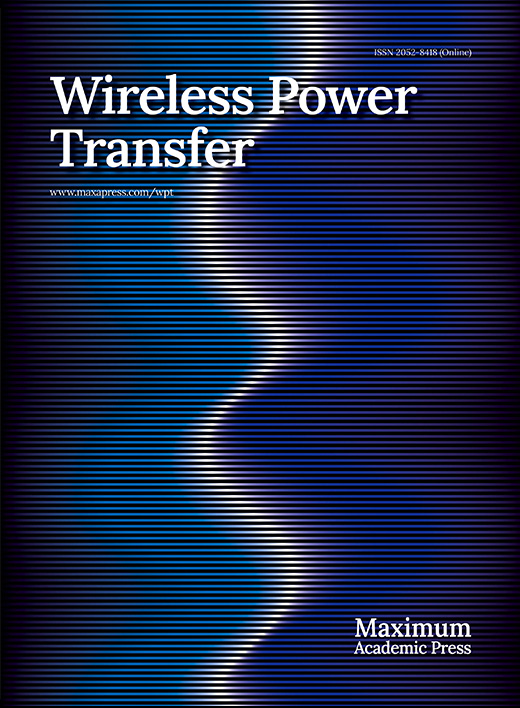






 Giuseppina Monti (M'16-SM'16) received the Laurea degree in telecommunication engineering (with honors) from the University of Bologna, Bologna, Italy, in 2003, and the Ph.D. degree in information engineering from the University of Salento, Lecce, Italy, in 2007. She is currently with the Department of Innovation Engineering, University of Salento, Lecce, Italy, as a Temporary Researcher and Lecturer in CAD of microwave circuits and antennas. Her current research interest includes the analysis and applications of artificial media, the design and realization of microwave components, MEMS-based reconfigurable antennas and devices, rectennas, and systems and devices for wireless power transmission applications. She has coauthored three book chapters and more than 150 papers in international conferences and journals.
Giuseppina Monti (M'16-SM'16) received the Laurea degree in telecommunication engineering (with honors) from the University of Bologna, Bologna, Italy, in 2003, and the Ph.D. degree in information engineering from the University of Salento, Lecce, Italy, in 2007. She is currently with the Department of Innovation Engineering, University of Salento, Lecce, Italy, as a Temporary Researcher and Lecturer in CAD of microwave circuits and antennas. Her current research interest includes the analysis and applications of artificial media, the design and realization of microwave components, MEMS-based reconfigurable antennas and devices, rectennas, and systems and devices for wireless power transmission applications. She has coauthored three book chapters and more than 150 papers in international conferences and journals.  Maria Valeria De Paolis received the M.S. degree in telecommunications engineering (cum laude) from the University of Salento, (Lecce, Italy) in 2014. She obtained the Ph.D. degree in Engineering of Complex Systems at the University of Salento (Lecce, Italy). Her work was focused on the design, characterization, and fabrication of wireless power transfer systems. In November 2017, she was contracted as a Post-Doctoral Researcher in the research laboratory of analysis and architecture of systems (LAAS-CNRS) of Toulouse (France). Her research activity is currently focused on the design and characterization of RF passive sensors.
Maria Valeria De Paolis received the M.S. degree in telecommunications engineering (cum laude) from the University of Salento, (Lecce, Italy) in 2014. She obtained the Ph.D. degree in Engineering of Complex Systems at the University of Salento (Lecce, Italy). Her work was focused on the design, characterization, and fabrication of wireless power transfer systems. In November 2017, she was contracted as a Post-Doctoral Researcher in the research laboratory of analysis and architecture of systems (LAAS-CNRS) of Toulouse (France). Her research activity is currently focused on the design and characterization of RF passive sensors.  Laura Corchia was born in Italy, in 1980. She received the M.S. degree in Telecommunication Engineering and the Ph.D in Information Engineering from University of Salento, Lecce, Italy, in 2007 and 2011, respectively. She is currently a Postdoctoral Researcher with the Department of Engineering for Innovation, University of Salento. Her research interests include the development of near and far field wireless power transfer links and power management units for wearable applications, the design and the fabrication of reconfigurable antennas, and the characterization of antennas and microwave devices.
Laura Corchia was born in Italy, in 1980. She received the M.S. degree in Telecommunication Engineering and the Ph.D in Information Engineering from University of Salento, Lecce, Italy, in 2007 and 2011, respectively. She is currently a Postdoctoral Researcher with the Department of Engineering for Innovation, University of Salento. Her research interests include the development of near and far field wireless power transfer links and power management units for wearable applications, the design and the fabrication of reconfigurable antennas, and the characterization of antennas and microwave devices.  Apostolos Georgiadis was born in Thessaloniki, Greece. He received the Ph.D. degree in electrical engineering from the University of Massachusetts, Amherst, in 2002. In March 2007 he joined CTTC, Spain as a senior researcher. In July 2016 he joined Heriot-Watt University, Edinburgh as an Associate Professor. He has been Associate Editor of the IEEE Microwave and Wireless Components Letters and the IET Microwaves, Antennas and Propagation. He co-founded and was Editor-in-Chief of the Cambridge Wireless Power Transfer Journal. He was a Distinguished Lecturer of IEEE Council on RFID. He is an URSI Fellow. He was a co-recipient of the 2016 Bell Labs Prize. His research interests include energy harvesting and wireless power transmission, RFID technology, active and phased array antennas, inkjet and 3D printed electronics, and millimeter wave systems. He has published more than 200 papers in peer reviewed journals and international conferences.
Apostolos Georgiadis was born in Thessaloniki, Greece. He received the Ph.D. degree in electrical engineering from the University of Massachusetts, Amherst, in 2002. In March 2007 he joined CTTC, Spain as a senior researcher. In July 2016 he joined Heriot-Watt University, Edinburgh as an Associate Professor. He has been Associate Editor of the IEEE Microwave and Wireless Components Letters and the IET Microwaves, Antennas and Propagation. He co-founded and was Editor-in-Chief of the Cambridge Wireless Power Transfer Journal. He was a Distinguished Lecturer of IEEE Council on RFID. He is an URSI Fellow. He was a co-recipient of the 2016 Bell Labs Prize. His research interests include energy harvesting and wireless power transmission, RFID technology, active and phased array antennas, inkjet and 3D printed electronics, and millimeter wave systems. He has published more than 200 papers in peer reviewed journals and international conferences. 



